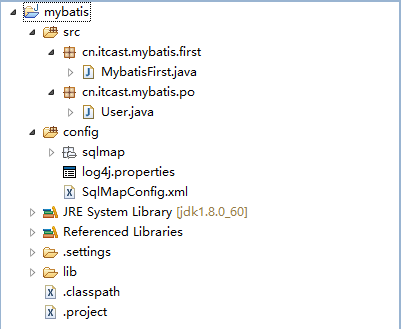Mybaits深入瞭解(二)—-入門例項
阿新 • • 發佈:2019-01-04
Mybatis CRUD例項
例項的開發環境
| java環境 | 開發工具 | 資料庫 |
|---|---|---|
| jdk1.7 | myeclipse | mysql |
專案的目錄結構

log4j.properties配置
Log4j是Apache的一個開放原始碼專案,通過使用Log4j,我們可以控制日誌資訊輸送的目的地是控制檯、檔案、GUI元件、甚至是套介面伺服器、NT的事件記錄器、UNIXSyslog守護程序等;我們也可以控制每一條日誌的輸出格式;通過定義每一條日誌資訊的級別,我們能夠更加細緻地控制日誌的生成過程。最令人感興趣的就是,這些可以通過一個配置檔案來靈活地進行配置,而不需要修改應用的程式碼。 此外,通過Log4j其他語言介面,您可以在C、C++、.Net、PL/SQL程式中使用Log4j,其語法和用法與在Java程式中一樣,使得多語言 分散式系統得到一個統一一致的日誌元件模組。而且,通過使用各種第三方擴充套件,您可以很方便地將Log4j整合到J2EE、JINI甚至是SNMP應用中。想要詳細瞭解的話可以看看下面的部落格: log4j.properties 詳解與配置步驟。在本專案中的配置:
# Global logging configuration
#在開發環境下日誌要設定成Debug,生產環境設定成info或error
log4j.rootLogger=DEBUG, stdout
# Console output...
log4j.appender.stdout=org.apache.log4j.ConsoleAppender
log4j.appender.stdout.layout=org.apache.log4j.PatternLayout
log4j.appender.stdout.layout SqlMapConfig.xml的配置
這是一個關鍵的配置檔案,是mybaits的全域性配置檔案,不過名稱不固定,主要是用來配置資料來源、事務等,mybaits的執行環境。
<?xml version="1.0" encoding="UTF-8" ?>
<!DOCTYPE configuration
PUBLIC "-//mybatis.org//DTD Config 3.0//EN"
"http://mybatis.org/dtd/mybatis-3-config.dtd">
<configuration 建立POJO類
package cn.itcast.mybatis.po;
import java.util.Date;
public class User {
private int id;
private String username;// 使用者姓名
private String sex;// 性別
private Date birthday;// 生日
private String address;// 地址
public int getId() {
return id;
}
public void setId(int id) {
this.id = id;
}
public String getUsername() {
return username;
}
public void setUsername(String username) {
this.username = username;
}
public String getSex() {
return sex;
}
public void setSex(String sex) {
this.sex = sex;
}
public Date getBirthday() {
return birthday;
}
public void setBirthday(Date birthday) {
this.birthday = birthday;
}
public String getAddress() {
return address;
}
public void setAddress(String address) {
this.address = address;
}
@Override
public String toString() {
return "User [id=" + id + ", username=" + username + ", sex=" + sex
+ ", birthday=" + birthday + ", address=" + address + "]";
}
}
對映檔案
對映檔案的命名最好規範統一下,本例項中命名為User.xml載對映檔案中配置sql語句。
<?xml version="1.0" encoding="UTF-8" ?>
<!DOCTYPE mapper
PUBLIC "-//mybatis.org//DTD Mapper 3.0//EN"
"http://mybatis.org/dtd/mybatis-3-mapper.dtd">
<mapper namespace="test">
<!-- 根據id獲取使用者資訊 -->
<select id="findUserById" parameterType="int" resultType="cn.itcast.mybatis.po.User">
select * from user where id = #{id}
</select>
<!-- 自定義條件查詢使用者列表 ,可能返回多條-->
<select id="findUserByUsername" parameterType="java.lang.String"
resultType="cn.itcast.mybatis.po.User">
select * from user where username like '%${value}%'
</select>
<!-- 新增使用者 AFTER LAST_INSERT_ID() -->
<insert id="insertUser" parameterType="cn.itcast.mybatis.po.User">
<selectKey keyProperty="id" order="AFTER" resultType="java.lang.Integer">
select LAST_INSERT_ID()
</selectKey>
insert into user(username,birthday,sex,address)
values(#{username},#{birthday},#{sex},#{address})
</insert>
<delete id="deleteUserById" parameterType="int">
delete from user where id=#{id}
</delete>
<update id="updateUser" parameterType="cn.itcast.mybatis.po.User">
update user set username=#{username},birthday=#{birthday},sex=#{sex},address=#{address} where id=#{id}
</update>
</mapper>
並在SqlMapConfig.xml檔案中載入對映檔案
<!-- 載入對映檔案 -->
<mappers>
<mapper resource="sqlmap/User.xml"/>
</mappers>具體程式碼實現
接下來就是具體的程式碼實現了,在MybatisFirst類中:
package cn.itcast.mybatis.first;
import java.io.IOException;
import java.io.InputStream;
import java.util.Date;
import java.util.List;
import org.apache.ibatis.io.Resources;
import org.apache.ibatis.session.SqlSession;
import org.apache.ibatis.session.SqlSessionFactory;
import org.apache.ibatis.session.SqlSessionFactoryBuilder;
import org.junit.Before;
import org.junit.Test;
import cn.itcast.mybatis.po.User;
public class MybatisFirst {
//建立會話工廠
private SqlSessionFactory sqlSessionFactory;
@Before
public void createSqlSessionFactory() throws IOException{
//配置檔案
String resource="SqlMapConfig.xml";
//得到配置檔案流
InputStream inputStream=Resources.getResourceAsStream(resource);
// 使用SqlSessionFactoryBuilder從xml配置檔案中建立SqlSessionFactory
sqlSessionFactory=new SqlSessionFactoryBuilder().build(inputStream);
}
@Test
public void findUserByIdTest() throws IOException{
SqlSession sqlSession=null;
try {
//建立資料庫會話例項
sqlSession=sqlSessionFactory.openSession();
//根據使用者ID查詢單個記錄
User user=sqlSession.selectOne("test.findUserById", 1);
System.out.println(user);
} catch (Exception e) {
e.printStackTrace();
} finally {
if (sqlSession != null) {
sqlSession.close();
}
}
}
@Test
public void findUserByUsername() throws IOException{
SqlSession sqlSession=null;
try {
//建立資料庫會話例項
sqlSession=sqlSessionFactory.openSession();
//根據使用者名稱查詢多條記錄
List<User> list=sqlSession.selectList("test.findUserByUsername","張");
System.out.println(list);
} catch (Exception e) {
e.printStackTrace();
} finally {
if (sqlSession != null) {
sqlSession.close();
}
}
}
@Test
public void testInsert(){
SqlSession sqlSession=null;
try {
sqlSession=sqlSessionFactory.openSession();
User user=new User();
user.setAddress("廊坊市廣陽區");
user.setBirthday(new Date());
user.setSex("1");
user.setUsername("張令");
sqlSession.insert("test.insertUser",user);
//提交事務
sqlSession.commit();
} catch (Exception e) {
e.printStackTrace();
}finally{
if(sqlSession!=null){
sqlSession.close();
}
}
}
@Test
public void testDelete(){
SqlSession sqlSession=null;
try {
sqlSession=sqlSessionFactory.openSession();
sqlSession.delete("test.deleteUserById",29);
//提交事務
sqlSession.commit();
} catch (Exception e) {
e.printStackTrace();
}finally{
if(sqlSession!=null){
sqlSession.close();
}
}
}
@Test
public void testUpdate(){
SqlSession sqlSession=null;
try {
sqlSession=sqlSessionFactory.openSession();
User user=new User();
user.setId(26);
user.setAddress("河北省南宮市");
user.setBirthday(new Date());
user.setSex("男");
user.setUsername("令仔");
sqlSession.update("test.updateUser",user);
//提交事務
sqlSession.commit();
} catch (Exception e) {
e.printStackTrace();
}finally{
if(sqlSession!=null){
sqlSession.close();
}
}
}
}
